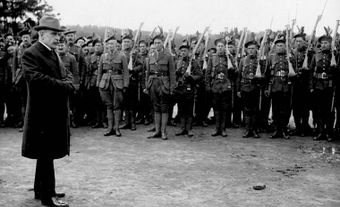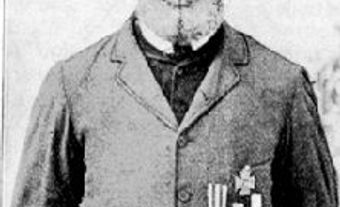Uniforms
Uniforms are garments of a similar ("uniform") pattern worn by a group of individuals to indicate their identity and function. Uniform clothing was used in ancient times and has been especially popular with the military since the emergence of standing armies in western Europe during the 17th century. Colonels of regiments found it convenient to require their troops to wear uniforms on which they could realize a profit from pay deductions, a system that lasted into the 1850s in the British army. Uniform colours varied greatly at first. In Canada, the first large body of uniformed men appeared in 1665 with the Carignan-Salières Regiment dressed in brown coats lined with white and grey, black hats and buff and black ribbons. Nations soon standardized the basic coat colours, though there were many exceptions. The colonial infantry companies that garrisoned New France from 1683 to 1760 had grey-white coats, the French infantry colour, with blue linings and cuffs. From 1716, the buttons were brass, the vest, breeches and stockings were blue, and a gold-laced tricorn was worn. The army regiments sent to Canada from 1755 until the Conquest of 1760 had the same dress with differences in colours, eg, the La Sarre Regiment had a red vest, with grey-white coat linings and grey-white breeches.
The distinctively coloured cuffs, collars, linings and lapels became known as "facings" in the red-coated British infantry; most units also had lace patterns peculiar to each regiment. Shades of yellow, green, blue or buff were the usual facing colours. The impression that the whole British army was in red coats should be dismissed: artillery wore blue with red facings, as did some support services. Green was also adopted by some light infantry and rifle corps from the end of the 18th century, notably Queen's Rangers (1791-1802) who served in Upper Canada.
The militia of New France had no official uniform. Only the officers were expected to wear gorgets and swords. When the Americans besieged Québec in 1775, the town's militia provided itself with green coats with buff waistcoats and breeches, the first instance that a sizable body of Canadian militiamen took to wearing a uniform. During the War of 1812 and the Rebellions of 1837, militiamen wore what they could get until proper uniforms arrived from England. Apart from the British army and the militia, some units were raised in Canada and dressed as regular troops. Until the 1850s a few units composed of wealthy militiamen uniformed themselves splendidly at their own cost. Canadians feared hostilities during the American Civil War and, in response to government encouragement, formed hundreds of companies. Rifle units usually wore green, artillery and cavalry blue in central Canada. On the Atlantic coast, the variety also extended to grey in many units. During the 1860s infantry units adopted scarlet with blue facings, rifle units green with red facings, artillery blue with red facings, and cavalry blue with buff facings. These are still the colours of the full-dress uniforms of most Canadian units. From the 1880s white pith helmets were popular. Highland dress also became established in several units. The South African War brought khaki uniforms to the Canadian contingents, but tradition died hard and some newly raised western cavalry regiments could be seen in scarlet around 1910. With WWI and WWII, khaki and steel helmets (from 1916) became universal because the greatly increased accuracy of weapons made easy targets of brightly coloured uniforms. The Canadians usually adopted patterns similar to the British.
Royal Canadian Navy uniforms resembled those of the British Royal Navy from 1910, the distinction being "HMCS" instead of "HMS" on the caps. The Canadian Air Force first had dark blue dress in 1920 but adopted the British Royal Air Force's blue-grey in 1924. "RCAF" (Royal Canadian Air Force) replaced "RAF" on the uniforms, and all 3 services had "Canada" on the upper sleeve. With Armed Forces unification in 1968 came the "CF Green" uniform which was the subject of controversy until the reversion to separate uniforms since 1984.
Associated with smartness and efficiency in the 19th century, uniforms became the fashion in certain civilian occupations. Post office, customs, marine service, railway, steamship and hotel employees, prison guards and even milkmen were often dressed in dark blue. Nurses wore only white until recently. Policemen in Canada have usually worn dark blue, except for the famous scarlet of the Royal Canadian Mounted Police. The basic styling was of British inspiration, although American influence has lately been considerable.

 Share on Facebook
Share on Facebook Share on X
Share on X Share by Email
Share by Email Share on Google Classroom
Share on Google Classroom














